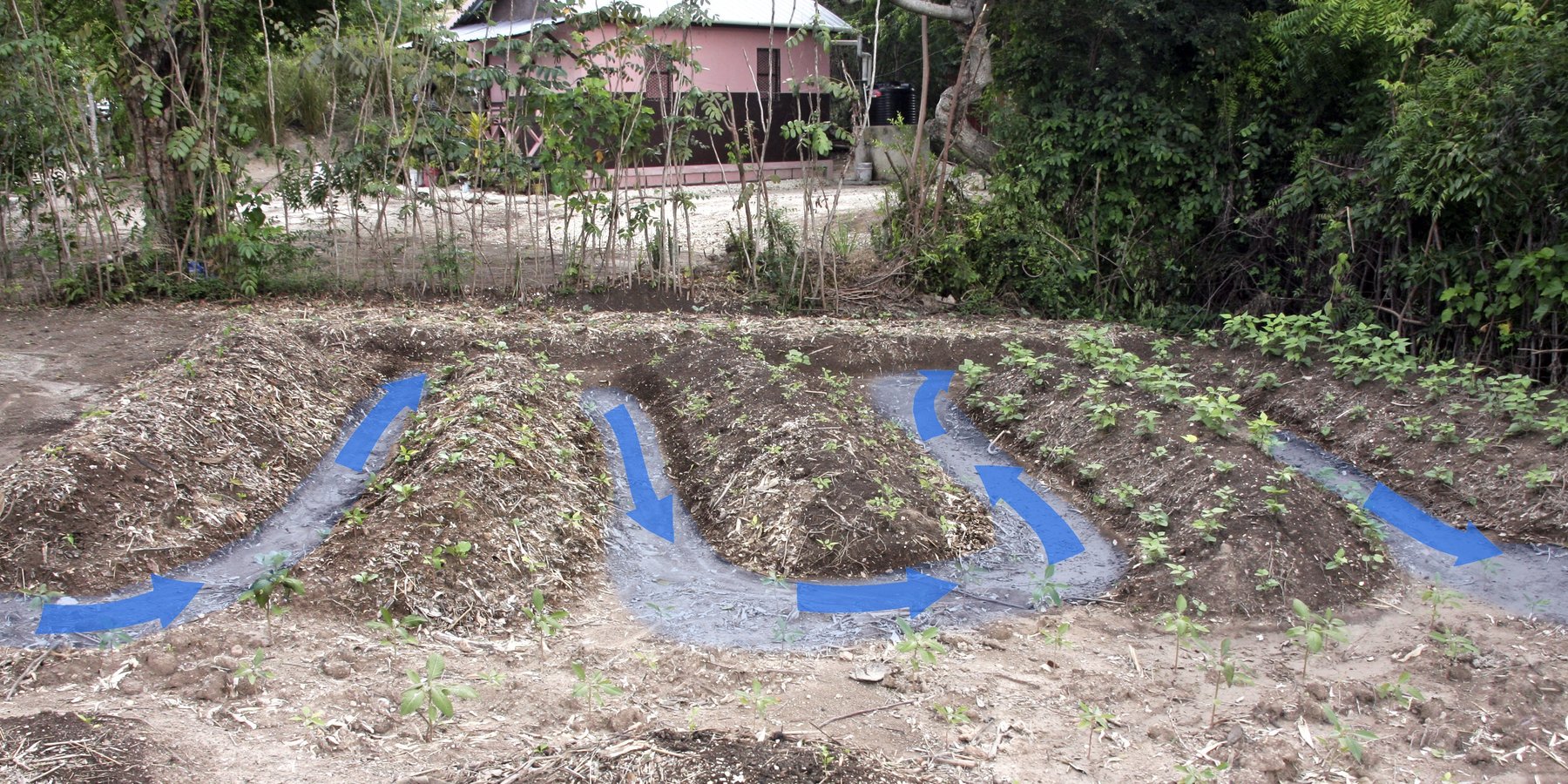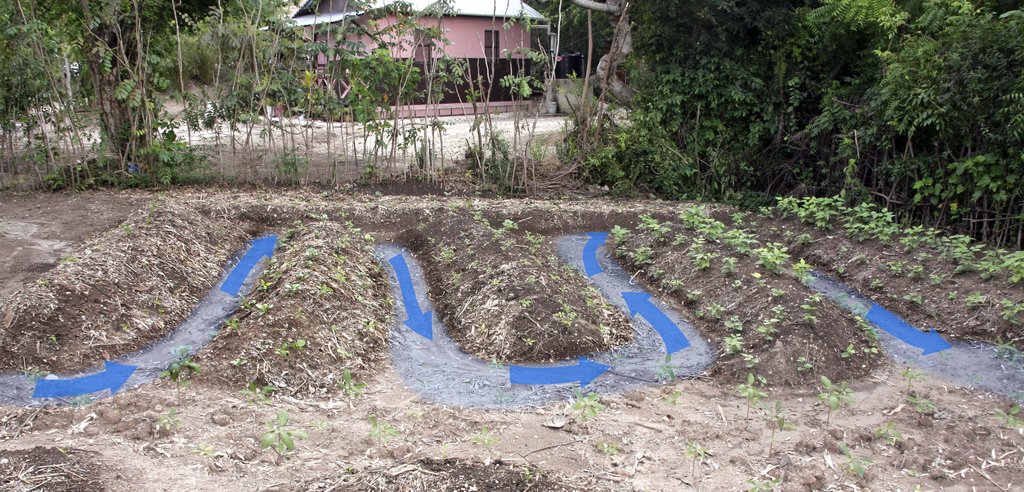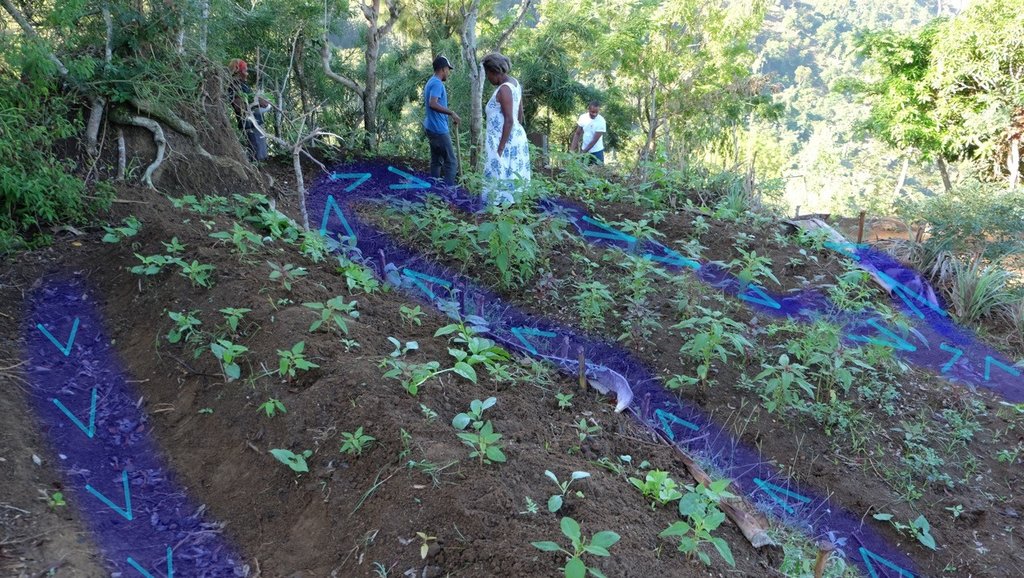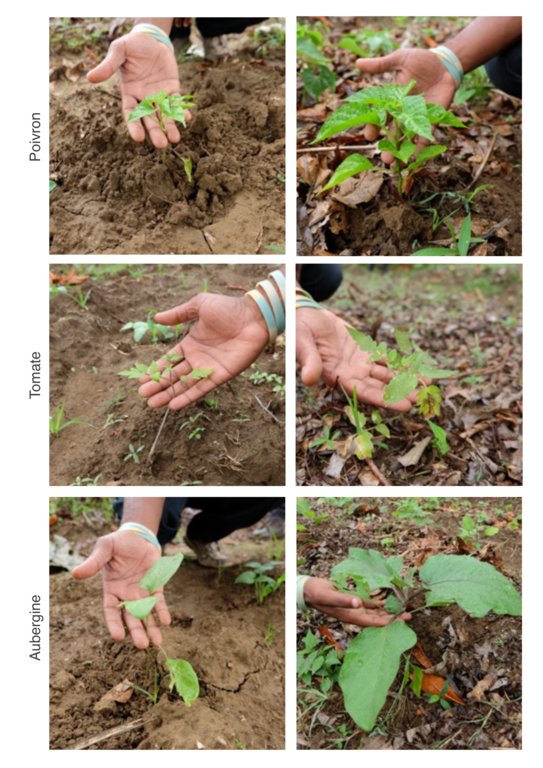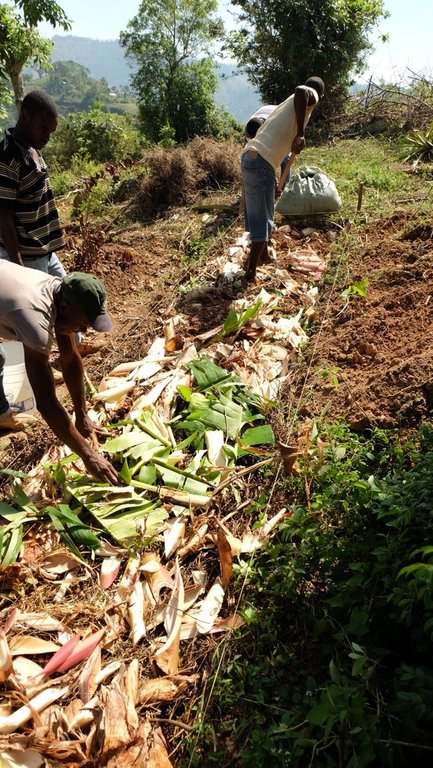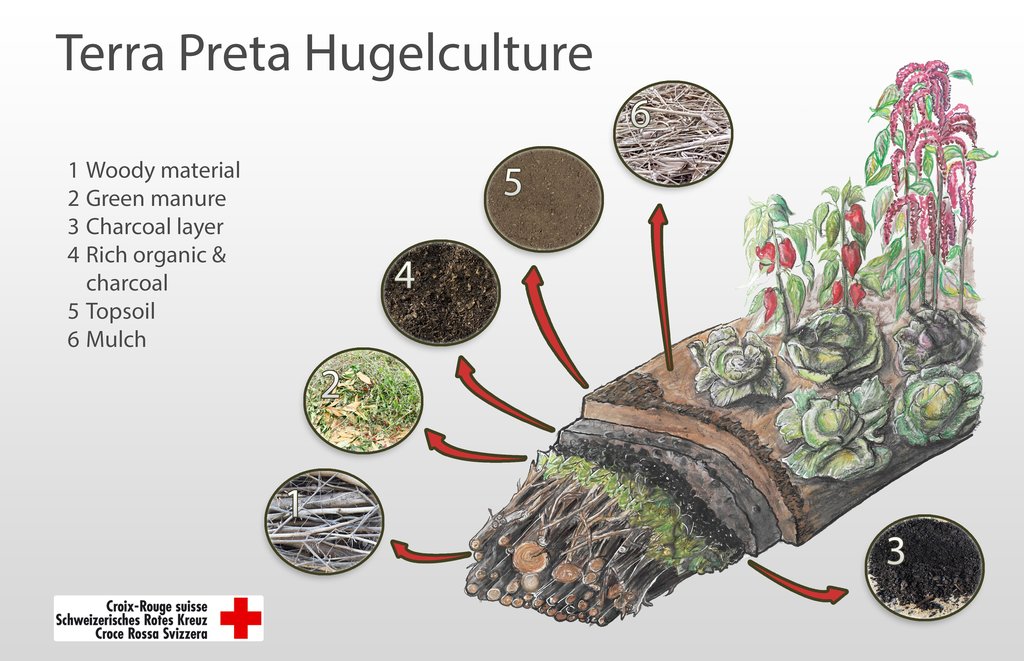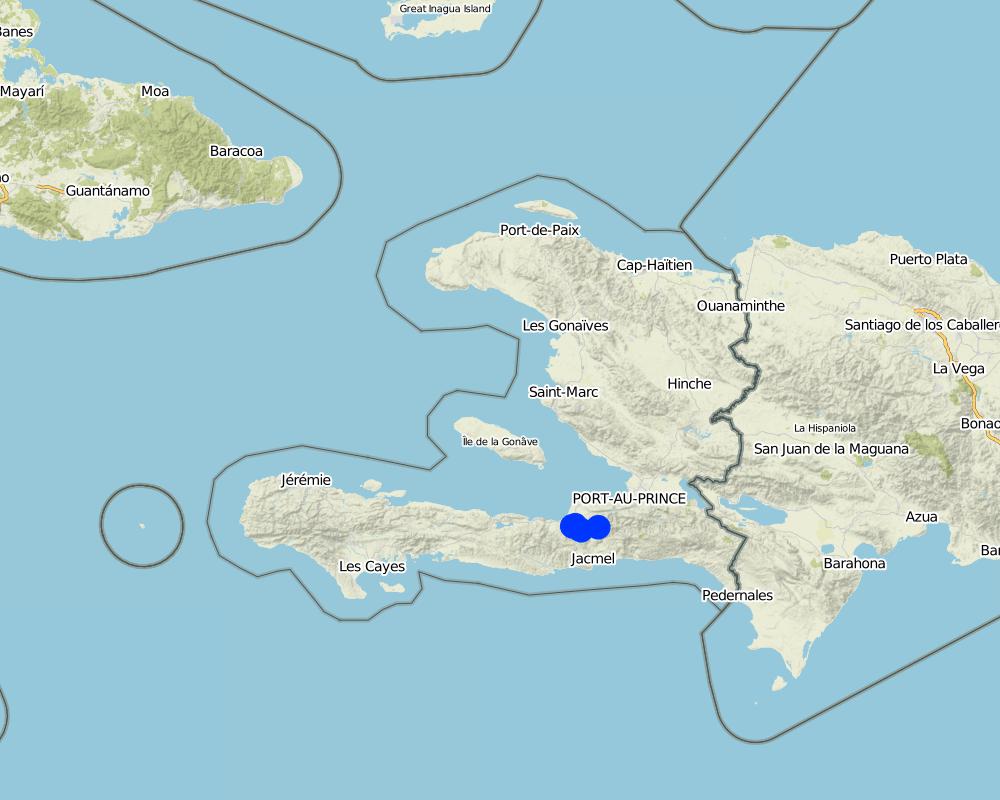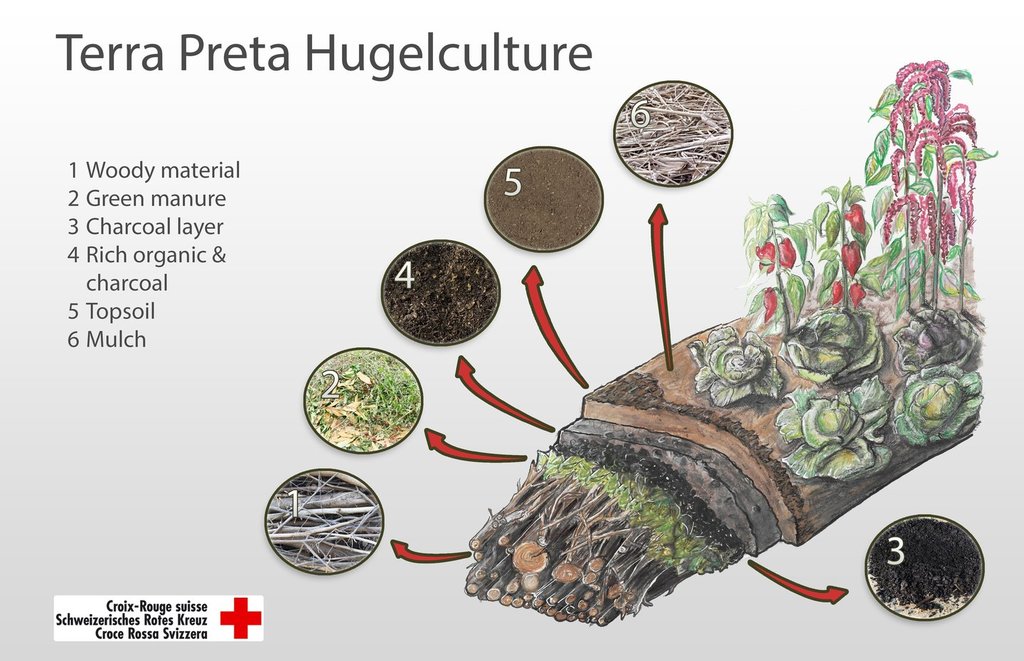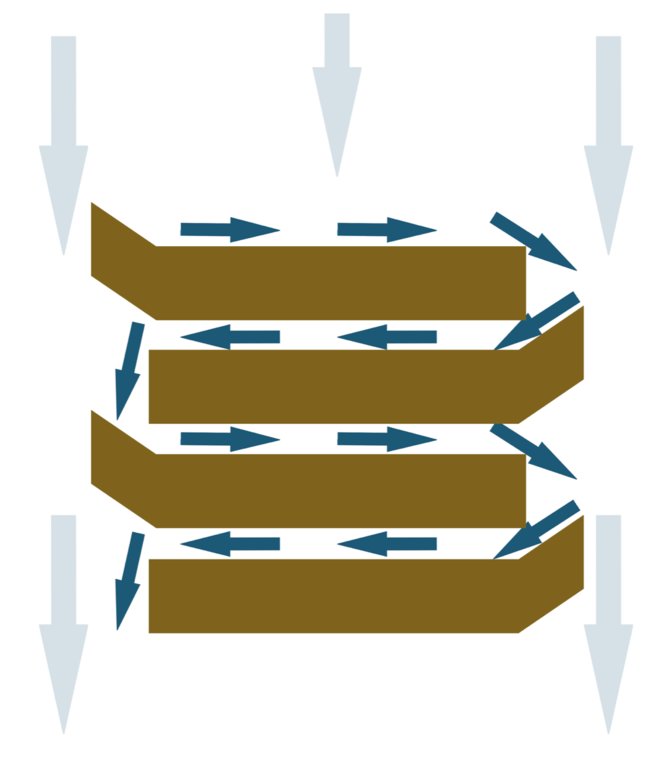Terra Preta raised garden beds [เฮติ]
- ผู้สร้างสรรค์:
- การอัพเดท:
- ผู้รวบรวม: Karl Harald Bier
- ผู้เรียบเรียง: Anton Jöhr
- ผู้ตรวจสอบ: David Beritault, Alexandra Gavilano
Jaden kolin, Tè mirak
technologies_935 - เฮติ
ดูส่วนย่อย
ขยายทั้งหมด ย่อทั้งหมด1. ข้อมูลทั่วไป
1.2 รายละเอียดที่ติดต่อได้ของผู้รวบรวมและองค์กรที่เกี่ยวข้องในการประเมินและการจัดเตรียมทำเอกสารของเทคโนโลยี
ชื่อของโครงการซึ่งอำนวยความสะดวกในการทำเอกสารหรือการประเมินเทคโนโลยี (ถ้าเกี่ยวข้อง)
Book project: where people and their land are safer - A Compendium of Good Practices in Disaster Risk Reduction (DRR) (where people and their land are safer)ชื่อขององค์กรซึ่งอำนวยความสะดวกในการทำเอกสารหรือการประเมินเทคโนโลยี (ถ้าเกี่ยวข้อง)
Swiss Red Cross (Swiss Red Cross) - สวิตเซอร์แลนด์1.3 เงื่อนไขการใช้ข้อมูลที่ได้บันทึกผ่านทาง WOCAT
ผู้รวบรวมและวิทยากรหลักยอมรับเงื่อนไขเกี่ยวกับการใช้ข้อมูลที่ถูกบันทึกผ่านทาง WOCAT:
ใช่
1.4 การเปิดเผยเรื่องความยั่งยืนของเทคโนโลยีที่ได้อธิบายไว้
เทคโนโลยีที่ได้อธิบายไว้นี้เป็นปัญหาของความเสื่อมโทรมโทรมของที่ดินหรือไม่ จึงไม่ได้รับการยอมรับว่าเป็นเทคโนโลยีเพื่อการจัดการที่ดินอย่างยั่งยืน:
ไม่ใช่
1.5 Reference to Questionnaire(s) on SLM Approaches (documented using WOCAT)
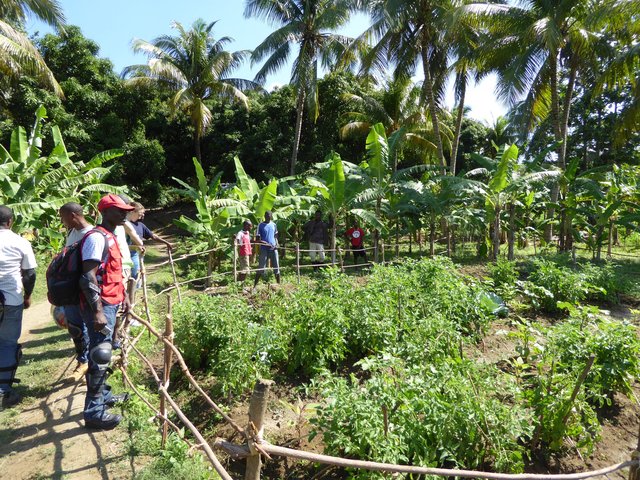
Approche au niveau ménage pour jardins Terra Preta [เฮติ]
L'approche des jardins Terra Preta au niveau ménage, avec des jardins de démonstration crée avec des membres des Organisations Communautaires de Base (OCB), facilite la vulgarisation de la technologie Terra Preta parmi la population vulnérable des zones rurales de la commune de Léogâne, Haïti.
- ผู้รวบรวม: Helen Gambon
2. การอธิบายลักษณะของเทคโนโลยี SLM
2.1 การอธิบายแบบสั้น ๆ ของเทคโนโลยี
คำจำกัดความของเทคโนโลยี:
Terra Preta raised garden beds are a combination of techniques from permaculture and the production of Terra Preta, an anthrosol. These garden beds, which were created with local resources, are highly fertile and enable the production of much higher yields than traditional techniques, while diminishing soil erosion.
2.2 การอธิบายแบบละเอียดของเทคโนโลยี
คำอธิบาย:
One of the major problems in the mountainous rural zones of the municipality of Léogâne in Haiti is the severe degradation and erosion of soils. The soil loss aggravates the vulnerable situation of the local population, mainly farmers. The Terra Preta raised garden beds were introduced in this region after the earthquake of 2010, and were replicated by several organisations and also by members of the communities. They are based on two main techniques:
1) Terra Preta is a technique to create soils based on a lacto-acidic fermentation of organic matter with charcoal powder. This technique was used by indigenous people in Amazonia, and rediscovered and replicated recently by scientists. The technique is characterised by the use of local resources and a high fertility. With this technique, a soil layer of several decimeters can be produced in a few years, whereas this takes normally around 100 years per centimeter. Soil analyses show that the formation of humic acids can be demonstrated after 4 months.
2) Raised garden beds (Hugelculture) are a technique from permaculture. Permaculture is a science of agricultural and social systems which uses the principles of ecology and the knowledge of traditional societies to simulate the diversity, stability and the resilience of natural ecosystems. Raised garden beds consist of an interior of ligneous material, covered by a layer of earth. The elevated construction facilitates the work in the garden and the decomposition of wood inside the beds. Due to their spongy structure, the raised garden beds function as a water reservoir during dry periods.
The garden beds are placed perpendicularly to the slope direction as much as possible, and are arranged alternately, with an extension to redirect the surface runoff towards the structures. This arrangement prevents the water from draining directly. This promotes the infiltration of water into the soil, where it is captured by the ligneous material, which prevents erosion (see the photograph).
The following inputs to the garden beds can be found locally:
- Organic matter: ligneous material, dry straw, fresh straw, harvest residues, organic residues rich in NPK (kitchen waste, animal waste, etc.),
- Charcoal powder (biochar),
- Possibly ashes or other fertile materials.
With these materials, which are generally without cost and locally available, a raised garden bed can be set up in less than an hour. Even without additional fertilisation after the set up, the technique offers the possibility to have several cycles of vegetable production. Experiments showed good results during 4 years of continuous plantation in Thozin (Grand Goâve). In order to secure soil fertility for many years, organic matter can be added after the period of plantation. It can be easily incorporated below the first layer of soil, and the decomposition takes place automatically. When put in place on sloping terrain, the garden beds slow down erosion strongly, and can serve to protect houses.
The technique is valued because of its cost-effectiveness and its sustainability compared to known techniques. The complexity of the implementation can be a limiting factor for an autonomous replication by the beneficiaries. That is when they see the set-up of the structures and think they know how to replicate it without taking account of all the details which are essential for the good functioning of the structures. This is why generally a certain level of support by technicians is required.
2.3 รูปภาพของเทคโนโลยี
2.5 ประเทศภูมิภาค หรือสถานที่ตั้งที่เทคโนโลยีได้นำไปใช้และได้รับการครอบคลุมโดยการประเมินนี้
ประเทศ:
เฮติ
ภูมิภาค/รัฐ/จังหวัด:
West department
ข้อมูลจำเพาะเพิ่มเติมของสถานที่ตั้ง :
Municipality of Léogâne
ระบุการกระจายตัวของเทคโนโลยี:
- ใช้ ณ จุดที่เฉพาะเจาะจงหรือเน้นไปยังบริเวณพื้นที่ขนาดเล็ก
Map
×2.6 วันที่การดำเนินการ
ถ้าไม่รู้ปีที่แน่นอน ให้ระบุวันที่โดยประมาณ:
- น้อยกว่า 10 ปี (ไม่นานนี้)
2.7 คำแนะนำของเทคโนโลยี
ให้ระบุว่าเทคโนโลยีถูกแนะนำเข้ามาอย่างไร:
- ทางโครงการหรือจากภายนอก
3. การจัดประเภทของเทคโนโลยี SLM
3.1 วัตถุประสงค์หลักของเทคโนโลยี
- ปรับปรุงการผลิตให้ดีขึ้น
- ลด ป้องกัน ฟื้นฟู การเสื่อมโทรมของที่ดิน
- ลดความเสี่ยงของภัยพิบัติ
- ชะลอการเปลี่ยนแปลงภูมิอากาศของโลกและผลกระทบ
- สร้างผลกระทบทางด้านเศรษฐกิจที่เป็นประโยชน์
- สร้างผลกระทบทางด้านสังคมที่เป็นประโยชน์
3.2 ประเภทของการใช้ที่ดินในปัจจุบันที่ได้นำเทคโนโลยีไปใช้

พื้นที่ปลูกพืช
- การปลูกพืชล้มลุกอายุปีเดียว
Annual cropping - Specify crops:
- vegetables - other
- vegetables - leafy vegetables (salads, cabbage, spinach, other)
- pepper, tomato, chili pepper
จำนวนของฤดูเพาะปลูกต่อปี:
- 2
ระบุ:
The intervention zone has 2 cropping periods based on 2 rainy seasons. The Terra Preta raised garden beds are usually used all year round.
แสดงความคิดเห็น:
Main crops (cash and food crops): Vegetables (for example pepper, cabbage, spinach, tomato, chili pepper)
With this technique, marginal land can be cultivated. The soil in place does not play a very important role because the nutrients are contained in the inputs.
3.3 Has land use changed due to the implementation of the Technology?
Has land use changed due to the implementation of the Technology?
- Yes (Please fill out the questions below with regard to the land use before implementation of the Technology)

ที่ดินที่ไม่ให้ผลผลิต
ระบุ:
Degraded soils, sandy or inert substrates
ข้อสังเกต:
The technology enables the production of vegetables on land that was not productive before (degraded soils, sandy or inert substrates). This allows farmers to diversify their traditional crops of maize, peas, sorghum and sweet potato with vegetables.
3.4 การใช้น้ำ
การใช้น้ำของที่ดินที่มีการใช้เทคโนโลยีอยู่:
- จากน้ำฝน
3.5 กลุ่ม SLM ที่ตรงกับเทคโนโลยีนี้
- การจัดการความอุดมสมบรูณ์ของดินแบบผสมผสาน
- มาตรการปลูกพืชขวางความลาดชัน (cross-slope measure)
- สวนครัว
3.6 มาตรการ SLM ที่ประกอบกันเป็นเทคโนโลยี

มาตรการจัดการพืช
- A2: อินทรียวัตถุในดิน/ความอุดมสมบูรณ์ในดิน
- A3: การรักษาหน้าดิน

มาตรการอนุรักษ์ด้วยโครงสร้าง
- S2: ทำนบ เขื่อนดิน
3.7 รูปแบบหลักของการเสื่อมโทรมของที่ดินที่ได้รับการแก้ไขโดยเทคโนโลยี

การกัดกร่อนของดินโดยน้ำ
- Wt (Loss of topsoil): การสูญเสียดินชั้นบนหรือการกัดกร่อนที่ผิวดิน
- Wg (Gully erosion): การกัดกร่อนแบบร่องธารหรือการทำให้เกิดร่องน้ำเซาะ

การเสื่อมโทรมของดินทางด้านชีวภาพ
- Bl (Loss of soil life): การสูญเสียสิ่งมีชีวิตในดิน
3.8 การป้องกัน การลดลง หรือการฟื้นฟูความเสื่อมโทรมของที่ดิน
ระบุเป้าหมายของเทคโนโลยีกับความเสื่อมโทรมของที่ดิน:
- ลดความเสื่อมโทรมของดิน
- ฟื้นฟูบำบัดที่ดินที่เสื่อมโทรมลงอย่างมาก
4. ข้อมูลจำเพาะด้านเทคนิค กิจกรรมการนำไปปฏิบัติใช้ ปัจจัยนำเข้า และค่าใช้จ่าย
4.1 แบบแปลนทางเทคนิคของเทคโนโลยี
ข้อมูลจำเพาะด้านเทคนิค (แบบแปลนทางเทคนิคของเทคโนโลยี):
1. Terrain analysis:
The first step in the construction is the terrain analysis: what is the size of the terrain, the relief, the environment (vegetation, buildings, water courses) and which are the resources (water, biochar, vegetation, animals, organic residues) present in place? Specific needs and social aspects, the neighbourhood and land holdings must also be considered.
2. Elaborating a land use plan:
The second step is the elaboration of a land use plan: definition of the position of the garden beds, of the protection measures (against wind, sun and heat), and of the vegetables to grow.
3. Construction of the garden beds:
After the preparatory work, the actual construction of the garden beds begins.
- A trench of approximately 10 cm depth is dug (width of 1-1.20 m, length undefined),
- The ligneous materials (decomposing wood, of larger or smaller volume) are arranged to create a mound. Holes between the materials should be filled-up with earth.
- The organic matter is added in layers in the following order: dry straw, animal waste, pulse crops and organic matter rich in NPK.
- Charcoal powder can be added between the layers of rich organic matter, or even better, mixed with the latter.
- A layer of earth of approximately 10 cm is added as cover.
- During the process of construction, every layer should be watered.
The establishment of multiple garden beds is done as described in figure 2 above. The garden beds are installed in alternation with an extension to redirect the surface runoff towards the structures. The water is forced around the structures, which will facilitate the infiltration of the water and the deposition of sediments. As a result, the water is captured in the garden bed, and erosion is reduced. A more detailed description with illustrations is given below.
ผู้เขียน:
Mariannina Oberhagen
วันที่:
01/01/2017
4.2 ข้อมูลทั่วไปเกี่ยวกับการคำนวณปัจจัยนำเข้าและค่าใช้จ่าย
ให้ระบุว่าค่าใช้จ่ายและปัจจัยนำเข้าได้รับการคำนวณอย่างไร:
- ต่อหน่วยเทคโนโลยี
โปรดระบุหน่วย:
isolated structure
Specify dimensions of unit (if relevant):
width: 1.10 m; length: 10 m
อื่นๆ หรือสกุลเงินประจำชาติ (ระบุ):
Haiti Gourde
If relevant, indicate exchange rate from USD to local currency (e.g. 1 USD = 79.9 Brazilian Real): 1 USD =:
68.0
ระบุค่าเฉลี่ยของค่าจ้างในการจ้างแรงงานต่อวัน:
250
4.3 กิจกรรมเพื่อการจัดตั้ง
| กิจกรรม | Timing (season) | |
|---|---|---|
| 1. | Outlining of raised garden beds | year-round |
| 2. | Collection of materials | year-round |
| 3. | Digging a basin along the contour | year-round, preferably at the start of the rainy season |
| 4. | Building the different layers (wood, dry straw, fresh straw, pulse crops and organic matter rich in NPK, earth, charcoal powder) | year-round, preferably at the start of the rainy season |
| 5. | Replanting of vegetable seedlings | year-round, preferably at the start of the rainy season |
| 6. | Watering | year-round, preferably at the start of the rainy season |
4.4 ค่าใช้จ่ายของปัจจัยนำเข้าที่จำเป็นสำหรับการจัดตั้ง
| ปัจจัยนำเข้า | หน่วย | ปริมาณ | ค่าใช้จ่ายต่อหน่วย | ค่าใช้จ่ายทั้งหมดต่อปัจจัยนำเข้า | %ของค่าใช้จ่ายที่ก่อให้เกิดขึ้นโดยผู้ใช้ที่ดิน | |
|---|---|---|---|---|---|---|
| แรงงาน | Skilled labour (technical support) | person-days | 0.5 | 3000.0 | 1500.0 | |
| แรงงาน | Unskilled labour (construction) | person-days | 1.0 | 250.0 | 250.0 | 100.0 |
| อุปกรณ์ | Tools (spade, pickaxe) | piece | 1.0 | 5.0 | 5.0 | 100.0 |
| วัสดุด้านพืช | Seedlings of cabbage | seedling | 10.0 | 10.0 | 100.0 | |
| วัสดุด้านพืช | Seedlings of spinach | seedling | 20.0 | 5.0 | 100.0 | |
| วัสดุด้านพืช | Seedlings of tomato | seedling | 10.0 | 5.0 | 50.0 | |
| วัสดุสำหรับก่อสร้าง | Decomposing wood | batch | 1.0 | 200.0 | 200.0 | 100.0 |
| วัสดุสำหรับก่อสร้าง | Earth | batch | 1.0 | 50.0 | 50.0 | 100.0 |
| วัสดุสำหรับก่อสร้าง | Dry straw | batch | 1.0 | 100.0 | 100.0 | 100.0 |
| วัสดุสำหรับก่อสร้าง | Fresh straw | batch | 1.0 | 100.0 | 100.0 | 100.0 |
| วัสดุสำหรับก่อสร้าง | Animal waste | Bag | 1.0 | 100.0 | 100.0 | 100.0 |
| วัสดุสำหรับก่อสร้าง | Charcoal/biochar | kg | 50.0 | 2.0 | 100.0 | 100.0 |
| ค่าใช้จ่ายทั้งหมดของการจัดตั้งเทคโนโลยี | 2655.0 | |||||
| Total costs for establishment of the Technology in USD | 39.04 | |||||
ถ้าผู้ใช้ที่ดินรับภาระน้อยกว่า 100% ของค่าใช้จ่าย ให้ระบุว่าใครเป็นผู้รับผิดชอบส่วนที่เหลือ:
Swiss Red Cross
แสดงความคิดเห็น:
The land users have the necessary tools (5 HTG are budgeted to compensate for the use of their own tools). The construction materials are also locally available, and are generally considered as waste.
4.5 การบำรุงรักษาสภาพหรือกิจกรรมที่เกิดขึ้นเป็นประจำ
| กิจกรรม | ช่วงระยะเวลา/ความถี่ | |
|---|---|---|
| 1. | watering | 3 days |
| 2. | weeding | 2 weeks |
| 3. | mulching | 2 months |
| 4. | refertilisation | 5 years |
4.6 ค่าใช้จ่ายของปัจจัยนำเข้าและกิจกรรมที่เกิดขึ้นเป็นประจำที่ต้องการการบำรุงรักษา (ต่อปี)
| ปัจจัยนำเข้า | หน่วย | ปริมาณ | ค่าใช้จ่ายต่อหน่วย | ค่าใช้จ่ายทั้งหมดต่อปัจจัยนำเข้า | %ของค่าใช้จ่ายที่ก่อให้เกิดขึ้นโดยผู้ใช้ที่ดิน | |
|---|---|---|---|---|---|---|
| แรงงาน | Annual maintenance | person-days | 15.0 | 250.0 | 3750.0 | 100.0 |
| อุปกรณ์ | Watering device | piece | 1.0 | 150.0 | 150.0 | 100.0 |
| วัสดุด้านพืช | Seed and seedlings | various | 1.0 | 250.0 | 250.0 | 100.0 |
| ค่าใช้จ่ายทั้งหมดของการบำรุงรักษาสภาพเทคโนโลยี | 4150.0 | |||||
| Total costs for maintenance of the Technology in USD | 61.03 | |||||
แสดงความคิดเห็น:
The indicated costs for the seed and the seedlings are the costs on the local market, but the land users reproduce these from existing plants, that they received from the project for the first implemented raised bed.
4.7 ปัจจัยสำคัญที่สุดที่มีผลกระทบต่อค่าใช้จ่าย
ปัจจัยสำคัญที่สุดที่มีผลกระทบต่อค่าใช้จ่ายต่างๆ:
The labour (and the technical support for the first 3-4 structures of raised beds).
5. สิ่งแวดล้อมทางธรรมชาติและของมนุษย์
5.1 ภูมิอากาศ
ฝนประจำปี
- < 250 ม.ม.
- 251-500 ม.ม.
- 501-750 ม.ม.
- 751-1,000 ม.ม.
- 1,001-1,500 ม.ม.
- 1,501-2,000 ม.ม.
- 2,001-3,000 ม.ม.
- 3,001-4,000 ม.ม.
- > 4,000 ม.ม.
ข้อมูลจำเพาะ/ความคิดเห็นเรื่องปริมาณน้ำฝน:
There is a dry season from December to February and a rainy season from April to October, with two peaks at the start and at the end of the period, and a relative pause in July.
เขตภูมิอากาศเกษตร
- กึ่งชุ่มชื้น
5.2 สภาพภูมิประเทศ
ค่าเฉลี่ยความลาดชัน:
- ราบเรียบ (0-2%)
- ลาดที่ไม่ชัน (3-5%)
- ปานกลาง (6-10%)
- เป็นลูกคลื่น (11-15%)
- เป็นเนิน (16-30%)
- ชัน (31-60%)
- ชันมาก (>60%)
ธรณีสัณฐาน:
- ที่ราบสูง/ที่ราบ
- สันเขา
- ไหล่เขา
- ไหล่เนินเขา
- ตีนเนิน
- หุบเขา
ระดับความสูง:
- 0-100 เมตร
- 101-500 เมตร
- 501-1,000 เมตร
- 1,001-1,500 เมตร
- 1,501-2,000 เมตร
- 2,001-2,500 เมตร
- 2,501-3,000 เมตร
- 3,001-4,000 เมตร
- > 4,000 เมตร
ให้ระบุถ้าเทคโนโลยีได้ถูกนำไปใช้:
- ไม่เกี่ยวข้อง
5.3 ดิน
ค่าเฉลี่ยความลึกของดิน:
- ตื้นมาก (0-20 ซ.ม.)
- ตื้น (21-50 ซ.ม.)
- ลึกปานกลาง (51-80 ซ.ม.)
- ลึก (81-120 ซ.ม.)
- ลึกมาก (>120 ซ.ม.)
เนื้อดิน (ดินชั้นบน):
- ปานกลาง (ดินร่วน ทรายแป้ง)
- ละเอียด/หนัก (ดินเหนียว)
เนื้อดินล่าง (> 20 ซ.ม.ต่ำจากผิวดิน):
- หยาบ/เบา (ดินทราย)
อินทรียวัตถุในดิน:
- ต่ำ (<1%)
5.4 ความเป็นประโยชน์และคุณภาพของน้ำ
ระดับน้ำใต้ดิน:
> 50 เมตร
น้ำไหลบ่าที่ผิวดิน:
ปานกลาง
คุณภาพน้ำ (ที่ยังไม่ได้บำบัด):
เป็นน้ำเพื่อการดื่มที่ไม่ดี (จำเป็นต้องได้รับการบำบัด)
ความเค็มของน้ำเป็นปัญหาหรือไม่:
ไม่ใช่
กำลังเกิดน้ำท่วมในพื้นที่หรือไม่:
ไม่ใช่
5.5 ความหลากหลายทางชีวภาพ
ความหลากหลายทางชนิดพันธุ์:
- ปานกลาง
ความหลากหลายของแหล่งที่อยู่:
- ต่ำ
5.6 ลักษณะของผู้ใช้ที่ดินที่นำเทคโนโลยีไปปฏิบัติใช้
อยู่กับที่หรือเร่ร่อน:
- อยู่กับที่
แนวทางการตลาดของระบบการผลิต:
- เพื่อการยังชีพ (หาเลี้ยงตนเอง)
รายได้ที่มาจากนอกฟาร์ม:
- < 10% ของรายได้ทั้งหมด
ระดับของความมั่งคั่งโดยเปรียบเทียบ:
- ยากจนมาก
เป็นรายบุคคล/ครัวเรือน:
- เป็นรายบุคคล/ครัวเรือน
ระดับของการใช้เครื่องจักรกล:
- งานที่ใช้แรงกาย
เพศ:
- หญิง
- ชาย
อายุของผู้ใช้ที่ดิน:
- วัยกลางคน
- ผู้สูงอายุ
5.7 Average area of land used by land users applying the Technology
- < 0.5 เฮกตาร์
- 0.5-1 เฮกตาร์
- 1-2 เฮกตาร์
- 2-5 เฮกตาร์
- 5-15 เฮกตาร์
- 15-50 เฮกตาร์
- 50-100 เฮกตาร์
- 100-500 เฮกตาร์
- 500-1,000 เฮกตาร์
- 1,000-10,000 เฮกตาร์
- >10,000 เฮกตาร์
พิจารณาว่าเป็นขนาดเล็ก กลาง หรือขนาดใหญ่ (ซึ่งอ้างอิงถึงบริบทระดับท้องถิ่น):
- ขนาดเล็ก
5.8 กรรมสิทธิ์ในที่ดิน สิทธิในการใช้ที่ดินและสิทธิในการใช้น้ำ
กรรมสิทธิ์ในที่ดิน:
- รายบุคคล ไม่ได้รับสิทธิครอบครอง
- รายบุคคล ได้รับสิทธิครอบครอง
สิทธิในการใช้ที่ดิน:
- รายบุคคล
สิทธิในการใช้น้ำ:
- เข้าถึงได้แบบเปิด (ไม่ได้จัดระเบียบ)
- รายบุคคล
5.9 การเข้าถึงบริการและโครงสร้างพื้นฐาน
สุขภาพ:
- จน
- ปานกลาง
- ดี
การศึกษา:
- จน
- ปานกลาง
- ดี
ความช่วยเหลือทางด้านเทคนิค:
- จน
- ปานกลาง
- ดี
การจ้างงาน (เช่น ภายนอกฟาร์ม):
- จน
- ปานกลาง
- ดี
ตลาด:
- จน
- ปานกลาง
- ดี
พลังงาน:
- จน
- ปานกลาง
- ดี
ถนนและการขนส่ง:
- จน
- ปานกลาง
- ดี
น้ำดื่มและการสุขาภิบาล:
- จน
- ปานกลาง
- ดี
บริการด้านการเงิน:
- จน
- ปานกลาง
- ดี
6. ผลกระทบและสรุปคำบอกกล่าว
6.1 ผลกระทบในพื้นที่ดำเนินการ (On-site) จากการใช้เทคโนโลยี
ผลกระทบทางด้านเศรษฐกิจและสังคม
การผลิต
การผลิตพืชผล
หลังจาก SLM:
an increase of yields by 2-3 times
แสดงความคิดเห็น/ระบุ:
The yield usually increases 2-3 times with the introduction of the technique.
คุณภาพพืชผล
แสดงความคิดเห็น/ระบุ:
The crops are more healthy and more resistant to diseases. The quality of the vegetables is better, and clients on the market of Grand Goâve pay more for the products from Terra Preta.
ความหลากหลายของผลิตภัณฑ์
แสดงความคิดเห็น/ระบุ:
The majority of persons in the area are not used to vegetable growing. The technique makes it possible to grow vegetables which increase the nutritional basis (rice, pearl millet, sweet potato and peas).
พื้นที่สำหรับการผลิต
แสดงความคิดเห็น/ระบุ:
Normally, the soils are not used for crop production. Through the technique production area is created. In addition, the surface increases through the undulated shape of the garden beds.
ผลกระทบด้านนิเวศวิทยา
วัฐจักรน้ำหรือน้ำบ่า
ปริมาณน้ำ
แสดงความคิดเห็น/ระบุ:
a) The infiltration of water in the soil is facilitated.
b) The water is retained by the organic matter in the garden beds (especially by the decomposing wood).
น้ำไหลบ่าที่ผิวดิน
ดิน
ความชื้นในดิน
การสะสมของดิน
แสดงความคิดเห็น/ระบุ:
Water erosion is slowed down by the garden beds, and the sediments are deposited in front of these. However, the size of the garden beds is limited, and in order to combat erosion on a larger scale additional measures must be considered, like vegetated barriers or terracing.
การอัดแน่นของดิน
อินทรียวัตถุในดิน/ต่ำกว่าดินชั้น C
แสดงความคิดเห็น/ระบุ:
Soil analyses
sample 1: 0.93%- >3.50%
sample 2: 2.04% - >5.51%
ลดความเสี่ยงของภัยพิบัติ
ผลกระทบจากภัยแล้ง
แสดงความคิดเห็น/ระบุ:
In the dry periods, the technique permits to continue crop production during several weeks without irrigation.
การปล่อยคาร์บอนและก๊าซเรือนกระจก
แสดงความคิดเห็น/ระบุ:
Sequestered in the soil by the charcoal and the organic matter (especially the ligneous material).
6.2 ผลกระทบนอกพื้นที่ดำเนินการ (Off-site) จากการใช้เทคโนโลยี
น้ำที่ใช้ประโยชน์ได้
ความเสียหายต่อโครงสร้างพื้นฐานของรัฐหรือของเอกชน
6.3 การเผชิญและความตอบสนองของเทคโนโลยีต่อการเปลี่ยนแปลงสภาพภูมิอากาศที่ค่อยเป็นค่อยไป และสภาพรุนแรงของภูมิอากาศ / ภัยพิบัติ (ที่รับรู้ได้โดยผู้ใช้ที่ดิน)
สภาพรุนแรงของภูมิอากาศ (ภัยพิบัติ)
ภัยพิบัติทางอุตุนิยมวิทยา
| เทคโนโลยีมีวิธีการรับมืออย่างไร | |
|---|---|
| พายุเขตร้อน | ปานกลาง |
| พายุฝนประจำท้องถิ่น | ดีมาก |
| พายุฝนฟ้าคะนองประจำท้องถิ่น | ดี |
6.4 การวิเคราะห์ค่าใช้จ่ายและผลประโยชน์ที่ได้รับ
ผลประโยชน์ที่ได้รับเปรียบเทียบกับค่าใช้จ่ายในการจัดตั้งเป็นอย่างไร (จากมุมมองของผู้ใช้ที่ดิน)
ผลตอบแทนระยะสั้น:
ด้านบวกอย่างมาก
ผลตอบแทนระยะยาว:
ด้านบวกอย่างมาก
ผลประโยชน์ที่ได้รับเปรียบเทียบกับค่าใช้จ่ายในการบำรุงรักษาหรือต้นทุนที่เกิดขึ้นซ้ำอีก เป็นอย่างไร (จากมุมมองของผู้ใช้ที่ดิน)
ผลตอบแทนระยะสั้น:
ด้านบวกอย่างมาก
ผลตอบแทนระยะยาว:
ด้านบวกอย่างมาก
6.5 การปรับตัวของเทคโนโลยี
- 1-10%
ถ้ามีข้อมูลให้บอกปริมาณด้วย (จำนวนของครัวเรือนหรือครอบคลุมพื้นที่):
>300 households
Of all those who have adopted the Technology, how many did so spontaneously, i.e. without receiving any material incentives/ payments?
- 51-90%
แสดงความคิดเห็น:
Small quantities of seed were given.
6.6 การปรับตัว
เทคโนโลยีได้รับการปรับเปลี่ยนเมื่อเร็วๆนี้ เพื่อให้ปรับตัวเข้ากับสภาพที่กำลังเปลี่ยนแปลงหรือไม่:
ไม่ใช่
6.7 จุดแข็ง / ข้อได้เปรียบ / โอกาสของเทคโนโลยี
| จุดแข็ง / ข้อได้เปรียบ / โอกาสในทัศนคติของผู้ใช้ที่ดิน |
|---|
| Strongly increased yield |
| Improved product quality (size, taste) |
| Shortened crop cycle |
| จุดแข็ง / ข้อได้เปรียบ / โอกาสในทัศนคติของผู้รวบรวมหรือวิทยากรหลัก |
|---|
| Increased production (several times) |
| Improved nutrition |
| Income generation for the farmers |
| Shortened production cycle |
6.8 จุดอ่อน / ข้อเสียเปรียบ / ความเสี่ยงของเทคโนโลยีและวิธีการแก้ไข
| จุดอ่อน / ข้อเสียเปรียบ / ความเสี่ยงในทัศนคติของผู้ใช้ที่ดิน | มีวิธีการแก้ไขได้อย่างไร |
|---|---|
| More work than traditional techniques. The latter are focused on agricultural production in fields (maize, pearl millet, sweet potato, peas/beans), and require considerably less daily maintenance. | By having the gardens close to the house for follow-up and support. |
| จุดอ่อน / ข้อเสียเปรียบ / ความเสี่ยงในทัศนคติของผู้รวบรวมหรือวิทยากรหลัก | มีวิธีการแก้ไขได้อย่างไร |
|---|---|
| Complexity of the technique | Regular education, follow-up and continuous support |
7. การอ้างอิงและการเชื่อมต่อ
7.1 วิธีการและแหล่งข้อมูล
- ไปเยี่ยมชมภาคสนาม การสำรวจพื้นที่ภาคสนาม
80
- การสัมภาษณ์กับผู้ใช้ที่ดิน
30
- การสัมภาษณ์ผู้เชี่ยวชาญด้าน SLM หรือผู้ชำนาญ
D. Buchon, external consultant
วันที่เก็บรวบรวมข้อมูล(ภาคสนาม) :
08/12/2016
7.2 การอ้างอิงถึงสิ่งตีพิมพ์
หัวข้อ, ผู้เขียน, ปี, หมายเลข ISBN:
Terra Preta: Production. Guide des méthodes de la production de Terra Preta dans les jardins potagères. Karl Harald Bier. 2013.
ชื่อเรื่อง ผู้เขียน ปี ISBN:
Welthungerhilfe
หัวข้อ, ผู้เขียน, ปี, หมายเลข ISBN:
Pas de la mise en place d'un Jardin Colline TP. Karl Harald Bier. Swiss Red Cross
ชื่อเรื่อง ผู้เขียน ปี ISBN:
info@redcross.ch
7.3 Links to relevant online information
ชื่อเรื่องหรือคำอธิบาย:
Terra Preta - Charbon bio - Climatefarming, Hans-Peter Schmidt, 2008, ISSN 1663-0521
URL:
http://www.ithaka-journal.net/climatefarming-fr1?lang=fr
ลิงก์และโมดูล
ขยายทั้งหมด ย่อทั้งหมดลิงก์

Approche au niveau ménage pour jardins Terra Preta [เฮติ]
L'approche des jardins Terra Preta au niveau ménage, avec des jardins de démonstration crée avec des membres des Organisations Communautaires de Base (OCB), facilite la vulgarisation de la technologie Terra Preta parmi la population vulnérable des zones rurales de la commune de Léogâne, Haïti.
- ผู้รวบรวม: Helen Gambon
โมดูล
ไม่มีโมดูล


